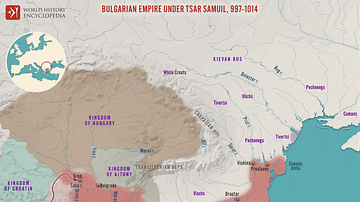Illustration
This map illustrates the Roman Empire’s territorial limits and provincial boundaries at the close of the Flavian dynasty, c. 96 CE. The sequence of emperors, Vespasian (reign 69 – 79 CE), Titus (reign 79 – 81 CE), and Domitian (reign 81 – 96 CE), was brief yet pivotal, restoring stability after Nero’s fall and a year of civil war.
The Flavians, an Italian gentry family outside the old aristocracy, broadened imperial administration by promoting equites (upper-class plebeians), suppressed revolt in Judea and destroyed the Second Temple (70 CE), financed and completed the Amphitheatrum Flavium, later called the Colosseum for its proximity to Nero’s colossal statue, endured Vesuvius’s eruption (79 CE), and imposed an uneasy peace on Dacia that would collapse under Trajan. Their reigns left a more centralized and resilient empire.
About the Author
Cite This Work
APA Style
Netchev, S. (2023, July 07). Map of the Roman Empire under the Flavian Dynasty. World History Encyclopedia. Retrieved from https://www.worldhistory.org/image/17609/map-of-the-roman-empire-under-the-flavian-dynasty/
Chicago Style
Netchev, Simeon. "Map of the Roman Empire under the Flavian Dynasty." World History Encyclopedia. Last modified July 07, 2023. https://www.worldhistory.org/image/17609/map-of-the-roman-empire-under-the-flavian-dynasty/.
MLA Style
Netchev, Simeon. "Map of the Roman Empire under the Flavian Dynasty." World History Encyclopedia. World History Encyclopedia, 07 Jul 2023, https://www.worldhistory.org/image/17609/map-of-the-roman-empire-under-the-flavian-dynasty/. Web. 04 Jul 2025.








